Coca-Cola: Analyzing Transport and Inventory Management Strategies
VerifiedAdded on 2019/10/18
|16
|4488
|457
Report
AI Summary
This report provides an in-depth analysis of Coca-Cola's transport and inventory management strategies. It examines the company's supply chain network, highlighting product movement from concentrate production to distribution centers and retailers. The report details Coca-Cola's warehouse facilities, including the use of RFID technology and automated systems, and discusses inventory management practices like periodic reviews and the EOQ model. Furthermore, it evaluates different intermodal choices, comparing trucking, water, and air transport, with a focus on the advantages of air transport. The report emphasizes the strong linkage between warehouse operations, inventory control, and intermodal selection, concluding that Coca-Cola's preference for air freight is crucial for timely and damage-free product delivery. Additionally, it references relevant literature to support its findings.

Running Head: TRANSPORT AND INVENTORY MANAGEMENT
transport and inventory management
[Document subtitle]
transport and inventory management
[Document subtitle]
Paraphrase This Document
Need a fresh take? Get an instant paraphrase of this document with our AI Paraphraser
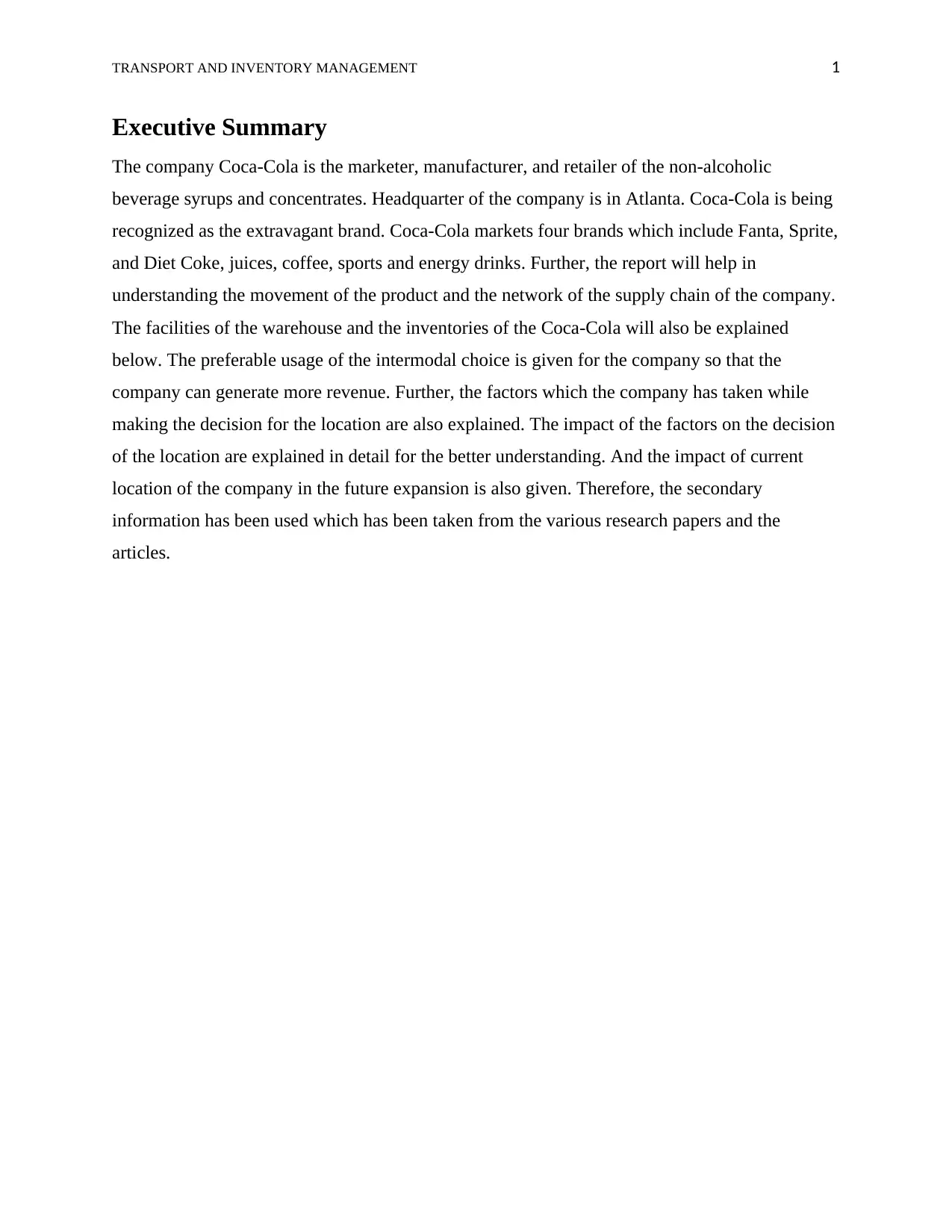
TRANSPORT AND INVENTORY MANAGEMENT 1
Executive Summary
The company Coca-Cola is the marketer, manufacturer, and retailer of the non-alcoholic
beverage syrups and concentrates. Headquarter of the company is in Atlanta. Coca-Cola is being
recognized as the extravagant brand. Coca-Cola markets four brands which include Fanta, Sprite,
and Diet Coke, juices, coffee, sports and energy drinks. Further, the report will help in
understanding the movement of the product and the network of the supply chain of the company.
The facilities of the warehouse and the inventories of the Coca-Cola will also be explained
below. The preferable usage of the intermodal choice is given for the company so that the
company can generate more revenue. Further, the factors which the company has taken while
making the decision for the location are also explained. The impact of the factors on the decision
of the location are explained in detail for the better understanding. And the impact of current
location of the company in the future expansion is also given. Therefore, the secondary
information has been used which has been taken from the various research papers and the
articles.
Executive Summary
The company Coca-Cola is the marketer, manufacturer, and retailer of the non-alcoholic
beverage syrups and concentrates. Headquarter of the company is in Atlanta. Coca-Cola is being
recognized as the extravagant brand. Coca-Cola markets four brands which include Fanta, Sprite,
and Diet Coke, juices, coffee, sports and energy drinks. Further, the report will help in
understanding the movement of the product and the network of the supply chain of the company.
The facilities of the warehouse and the inventories of the Coca-Cola will also be explained
below. The preferable usage of the intermodal choice is given for the company so that the
company can generate more revenue. Further, the factors which the company has taken while
making the decision for the location are also explained. The impact of the factors on the decision
of the location are explained in detail for the better understanding. And the impact of current
location of the company in the future expansion is also given. Therefore, the secondary
information has been used which has been taken from the various research papers and the
articles.
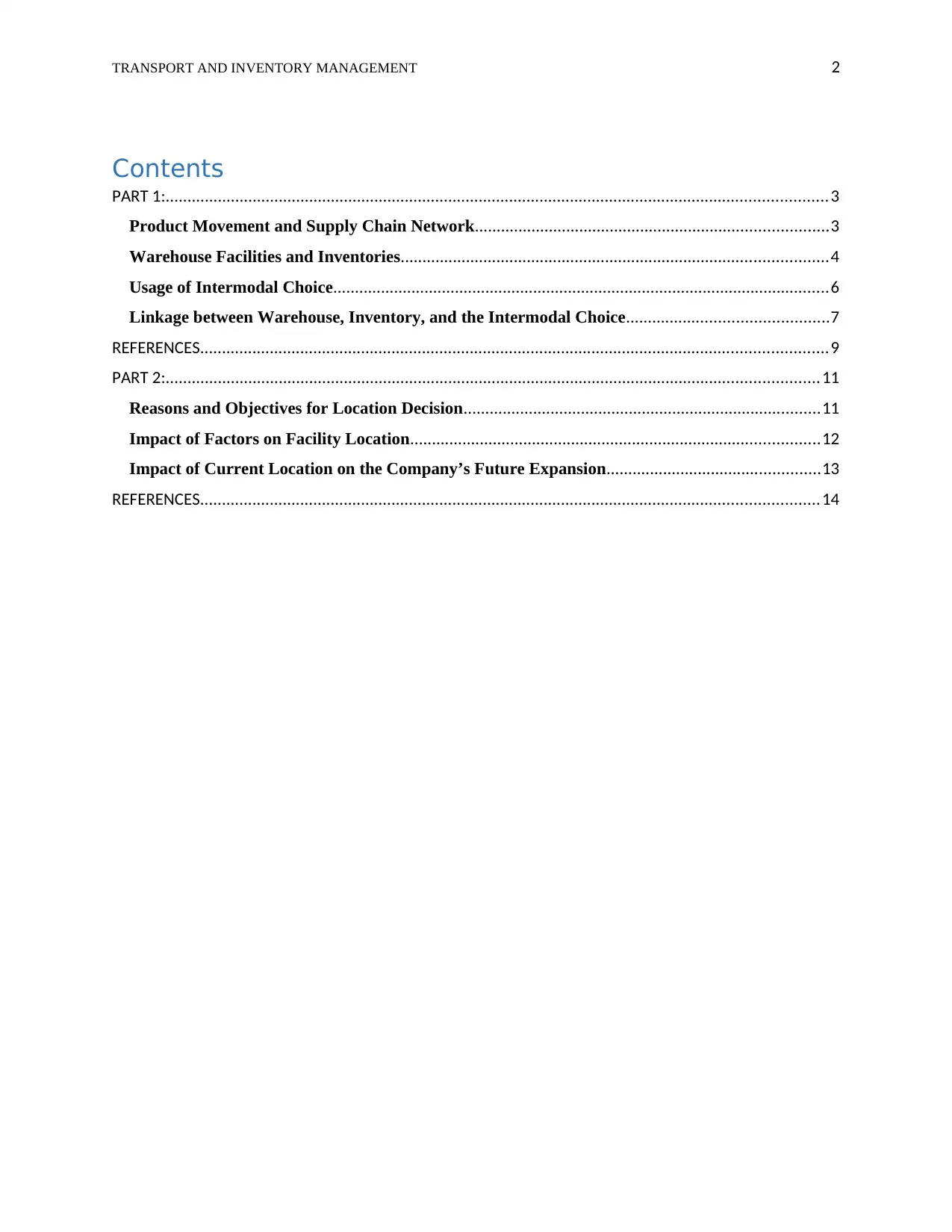
TRANSPORT AND INVENTORY MANAGEMENT 2
Contents
PART 1:........................................................................................................................................................3
Product Movement and Supply Chain Network.................................................................................3
Warehouse Facilities and Inventories..................................................................................................4
Usage of Intermodal Choice..................................................................................................................6
Linkage between Warehouse, Inventory, and the Intermodal Choice..............................................7
REFERENCES................................................................................................................................................9
PART 2:......................................................................................................................................................11
Reasons and Objectives for Location Decision..................................................................................11
Impact of Factors on Facility Location..............................................................................................12
Impact of Current Location on the Company’s Future Expansion.................................................13
REFERENCES..............................................................................................................................................14
Contents
PART 1:........................................................................................................................................................3
Product Movement and Supply Chain Network.................................................................................3
Warehouse Facilities and Inventories..................................................................................................4
Usage of Intermodal Choice..................................................................................................................6
Linkage between Warehouse, Inventory, and the Intermodal Choice..............................................7
REFERENCES................................................................................................................................................9
PART 2:......................................................................................................................................................11
Reasons and Objectives for Location Decision..................................................................................11
Impact of Factors on Facility Location..............................................................................................12
Impact of Current Location on the Company’s Future Expansion.................................................13
REFERENCES..............................................................................................................................................14
⊘ This is a preview!⊘
Do you want full access?
Subscribe today to unlock all pages.

Trusted by 1+ million students worldwide
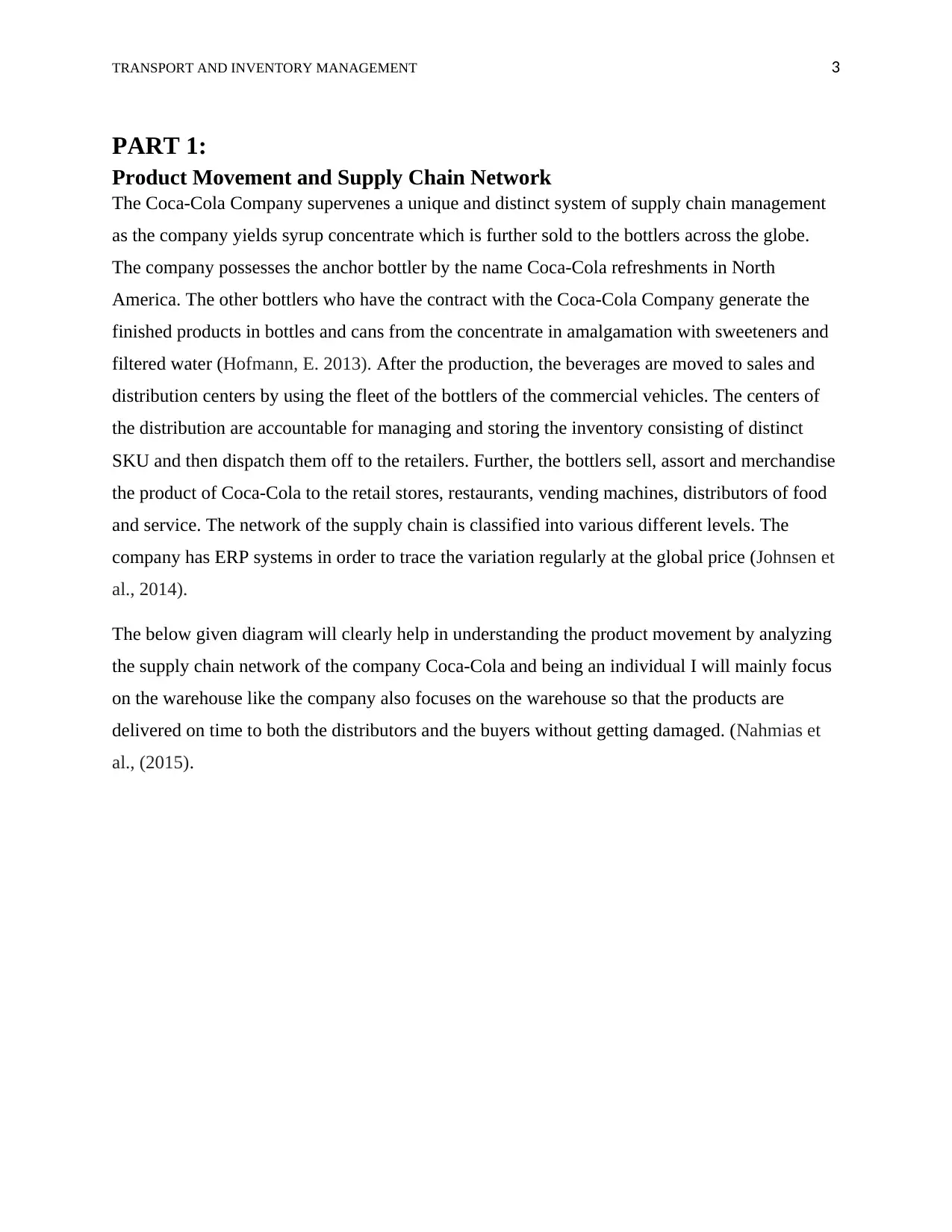
TRANSPORT AND INVENTORY MANAGEMENT 3
PART 1:
Product Movement and Supply Chain Network
The Coca-Cola Company supervenes a unique and distinct system of supply chain management
as the company yields syrup concentrate which is further sold to the bottlers across the globe.
The company possesses the anchor bottler by the name Coca-Cola refreshments in North
America. The other bottlers who have the contract with the Coca-Cola Company generate the
finished products in bottles and cans from the concentrate in amalgamation with sweeteners and
filtered water (Hofmann, E. 2013). After the production, the beverages are moved to sales and
distribution centers by using the fleet of the bottlers of the commercial vehicles. The centers of
the distribution are accountable for managing and storing the inventory consisting of distinct
SKU and then dispatch them off to the retailers. Further, the bottlers sell, assort and merchandise
the product of Coca-Cola to the retail stores, restaurants, vending machines, distributors of food
and service. The network of the supply chain is classified into various different levels. The
company has ERP systems in order to trace the variation regularly at the global price (Johnsen et
al., 2014).
The below given diagram will clearly help in understanding the product movement by analyzing
the supply chain network of the company Coca-Cola and being an individual I will mainly focus
on the warehouse like the company also focuses on the warehouse so that the products are
delivered on time to both the distributors and the buyers without getting damaged. (Nahmias et
al., (2015).
PART 1:
Product Movement and Supply Chain Network
The Coca-Cola Company supervenes a unique and distinct system of supply chain management
as the company yields syrup concentrate which is further sold to the bottlers across the globe.
The company possesses the anchor bottler by the name Coca-Cola refreshments in North
America. The other bottlers who have the contract with the Coca-Cola Company generate the
finished products in bottles and cans from the concentrate in amalgamation with sweeteners and
filtered water (Hofmann, E. 2013). After the production, the beverages are moved to sales and
distribution centers by using the fleet of the bottlers of the commercial vehicles. The centers of
the distribution are accountable for managing and storing the inventory consisting of distinct
SKU and then dispatch them off to the retailers. Further, the bottlers sell, assort and merchandise
the product of Coca-Cola to the retail stores, restaurants, vending machines, distributors of food
and service. The network of the supply chain is classified into various different levels. The
company has ERP systems in order to trace the variation regularly at the global price (Johnsen et
al., 2014).
The below given diagram will clearly help in understanding the product movement by analyzing
the supply chain network of the company Coca-Cola and being an individual I will mainly focus
on the warehouse like the company also focuses on the warehouse so that the products are
delivered on time to both the distributors and the buyers without getting damaged. (Nahmias et
al., (2015).
Paraphrase This Document
Need a fresh take? Get an instant paraphrase of this document with our AI Paraphraser
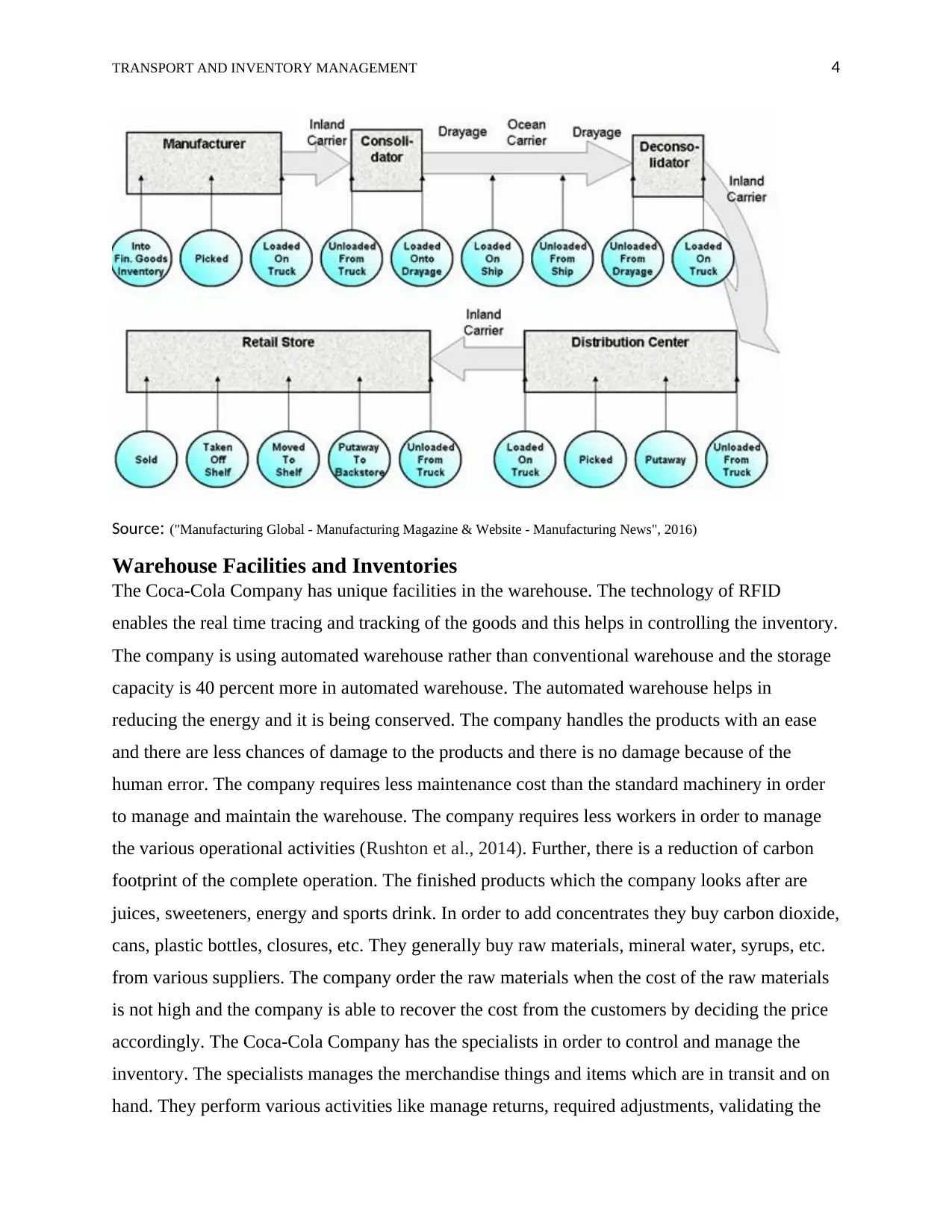
TRANSPORT AND INVENTORY MANAGEMENT 4
Source: ("Manufacturing Global - Manufacturing Magazine & Website - Manufacturing News", 2016)
Warehouse Facilities and Inventories
The Coca-Cola Company has unique facilities in the warehouse. The technology of RFID
enables the real time tracing and tracking of the goods and this helps in controlling the inventory.
The company is using automated warehouse rather than conventional warehouse and the storage
capacity is 40 percent more in automated warehouse. The automated warehouse helps in
reducing the energy and it is being conserved. The company handles the products with an ease
and there are less chances of damage to the products and there is no damage because of the
human error. The company requires less maintenance cost than the standard machinery in order
to manage and maintain the warehouse. The company requires less workers in order to manage
the various operational activities (Rushton et al., 2014). Further, there is a reduction of carbon
footprint of the complete operation. The finished products which the company looks after are
juices, sweeteners, energy and sports drink. In order to add concentrates they buy carbon dioxide,
cans, plastic bottles, closures, etc. They generally buy raw materials, mineral water, syrups, etc.
from various suppliers. The company order the raw materials when the cost of the raw materials
is not high and the company is able to recover the cost from the customers by deciding the price
accordingly. The Coca-Cola Company has the specialists in order to control and manage the
inventory. The specialists manages the merchandise things and items which are in transit and on
hand. They perform various activities like manage returns, required adjustments, validating the
Source: ("Manufacturing Global - Manufacturing Magazine & Website - Manufacturing News", 2016)
Warehouse Facilities and Inventories
The Coca-Cola Company has unique facilities in the warehouse. The technology of RFID
enables the real time tracing and tracking of the goods and this helps in controlling the inventory.
The company is using automated warehouse rather than conventional warehouse and the storage
capacity is 40 percent more in automated warehouse. The automated warehouse helps in
reducing the energy and it is being conserved. The company handles the products with an ease
and there are less chances of damage to the products and there is no damage because of the
human error. The company requires less maintenance cost than the standard machinery in order
to manage and maintain the warehouse. The company requires less workers in order to manage
the various operational activities (Rushton et al., 2014). Further, there is a reduction of carbon
footprint of the complete operation. The finished products which the company looks after are
juices, sweeteners, energy and sports drink. In order to add concentrates they buy carbon dioxide,
cans, plastic bottles, closures, etc. They generally buy raw materials, mineral water, syrups, etc.
from various suppliers. The company order the raw materials when the cost of the raw materials
is not high and the company is able to recover the cost from the customers by deciding the price
accordingly. The Coca-Cola Company has the specialists in order to control and manage the
inventory. The specialists manages the merchandise things and items which are in transit and on
hand. They perform various activities like manage returns, required adjustments, validating the
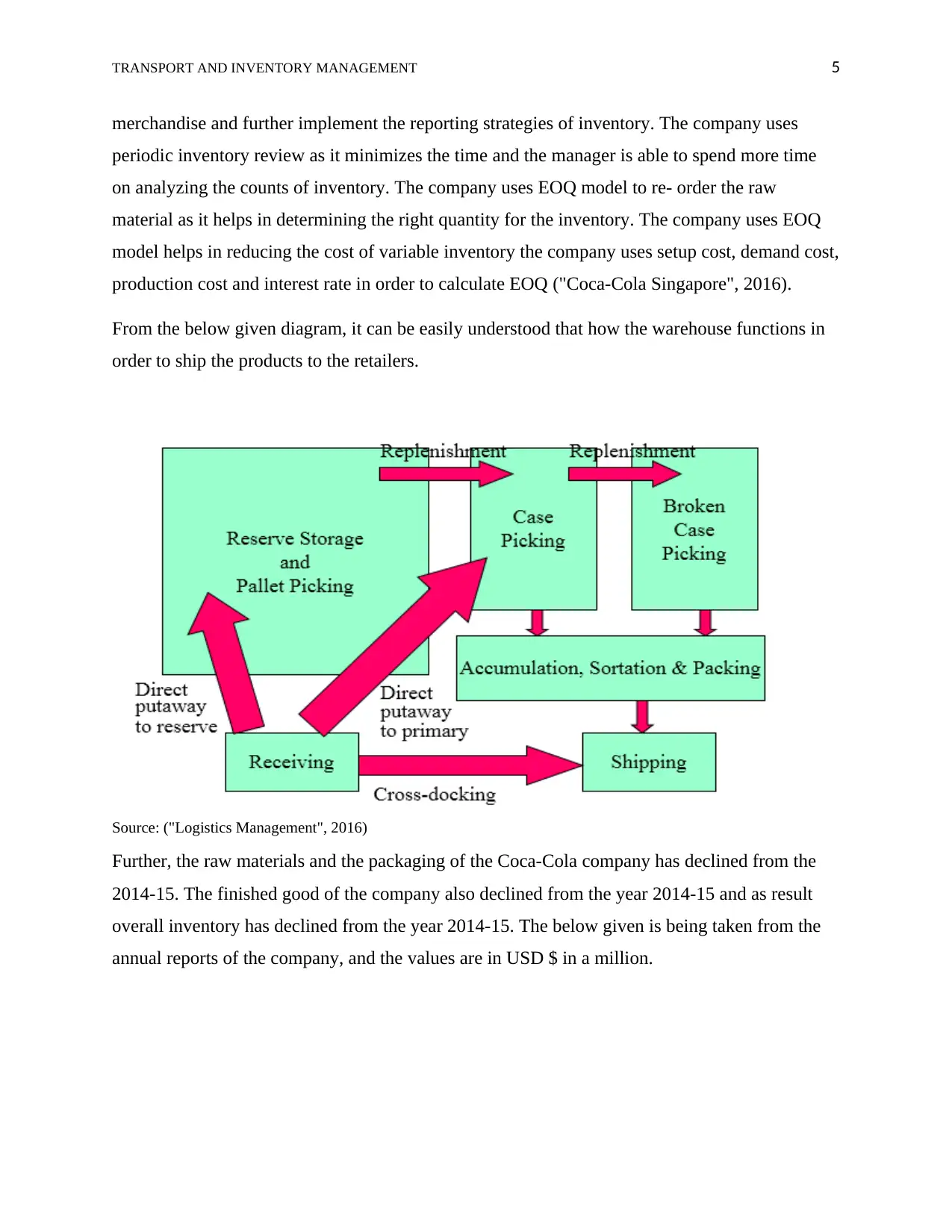
TRANSPORT AND INVENTORY MANAGEMENT 5
merchandise and further implement the reporting strategies of inventory. The company uses
periodic inventory review as it minimizes the time and the manager is able to spend more time
on analyzing the counts of inventory. The company uses EOQ model to re- order the raw
material as it helps in determining the right quantity for the inventory. The company uses EOQ
model helps in reducing the cost of variable inventory the company uses setup cost, demand cost,
production cost and interest rate in order to calculate EOQ ("Coca-Cola Singapore", 2016).
From the below given diagram, it can be easily understood that how the warehouse functions in
order to ship the products to the retailers.
Source: ("Logistics Management", 2016)
Further, the raw materials and the packaging of the Coca-Cola company has declined from the
2014-15. The finished good of the company also declined from the year 2014-15 and as result
overall inventory has declined from the year 2014-15. The below given is being taken from the
annual reports of the company, and the values are in USD $ in a million.
merchandise and further implement the reporting strategies of inventory. The company uses
periodic inventory review as it minimizes the time and the manager is able to spend more time
on analyzing the counts of inventory. The company uses EOQ model to re- order the raw
material as it helps in determining the right quantity for the inventory. The company uses EOQ
model helps in reducing the cost of variable inventory the company uses setup cost, demand cost,
production cost and interest rate in order to calculate EOQ ("Coca-Cola Singapore", 2016).
From the below given diagram, it can be easily understood that how the warehouse functions in
order to ship the products to the retailers.
Source: ("Logistics Management", 2016)
Further, the raw materials and the packaging of the Coca-Cola company has declined from the
2014-15. The finished good of the company also declined from the year 2014-15 and as result
overall inventory has declined from the year 2014-15. The below given is being taken from the
annual reports of the company, and the values are in USD $ in a million.
⊘ This is a preview!⊘
Do you want full access?
Subscribe today to unlock all pages.

Trusted by 1+ million students worldwide
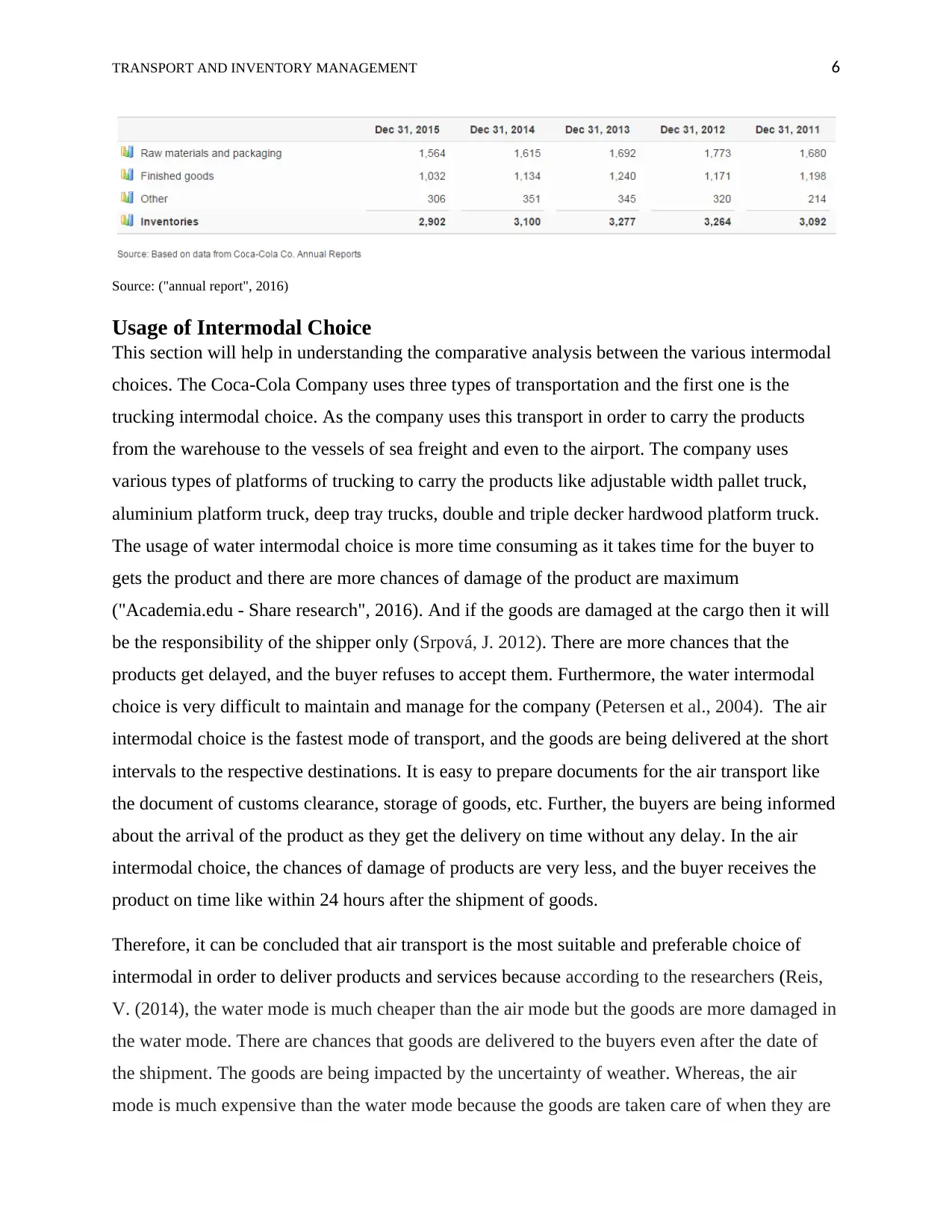
TRANSPORT AND INVENTORY MANAGEMENT 6
Source: ("annual report", 2016)
Usage of Intermodal Choice
This section will help in understanding the comparative analysis between the various intermodal
choices. The Coca-Cola Company uses three types of transportation and the first one is the
trucking intermodal choice. As the company uses this transport in order to carry the products
from the warehouse to the vessels of sea freight and even to the airport. The company uses
various types of platforms of trucking to carry the products like adjustable width pallet truck,
aluminium platform truck, deep tray trucks, double and triple decker hardwood platform truck.
The usage of water intermodal choice is more time consuming as it takes time for the buyer to
gets the product and there are more chances of damage of the product are maximum
("Academia.edu - Share research", 2016). And if the goods are damaged at the cargo then it will
be the responsibility of the shipper only (Srpová, J. 2012). There are more chances that the
products get delayed, and the buyer refuses to accept them. Furthermore, the water intermodal
choice is very difficult to maintain and manage for the company (Petersen et al., 2004). The air
intermodal choice is the fastest mode of transport, and the goods are being delivered at the short
intervals to the respective destinations. It is easy to prepare documents for the air transport like
the document of customs clearance, storage of goods, etc. Further, the buyers are being informed
about the arrival of the product as they get the delivery on time without any delay. In the air
intermodal choice, the chances of damage of products are very less, and the buyer receives the
product on time like within 24 hours after the shipment of goods.
Therefore, it can be concluded that air transport is the most suitable and preferable choice of
intermodal in order to deliver products and services because according to the researchers (Reis,
V. (2014), the water mode is much cheaper than the air mode but the goods are more damaged in
the water mode. There are chances that goods are delivered to the buyers even after the date of
the shipment. The goods are being impacted by the uncertainty of weather. Whereas, the air
mode is much expensive than the water mode because the goods are taken care of when they are
Source: ("annual report", 2016)
Usage of Intermodal Choice
This section will help in understanding the comparative analysis between the various intermodal
choices. The Coca-Cola Company uses three types of transportation and the first one is the
trucking intermodal choice. As the company uses this transport in order to carry the products
from the warehouse to the vessels of sea freight and even to the airport. The company uses
various types of platforms of trucking to carry the products like adjustable width pallet truck,
aluminium platform truck, deep tray trucks, double and triple decker hardwood platform truck.
The usage of water intermodal choice is more time consuming as it takes time for the buyer to
gets the product and there are more chances of damage of the product are maximum
("Academia.edu - Share research", 2016). And if the goods are damaged at the cargo then it will
be the responsibility of the shipper only (Srpová, J. 2012). There are more chances that the
products get delayed, and the buyer refuses to accept them. Furthermore, the water intermodal
choice is very difficult to maintain and manage for the company (Petersen et al., 2004). The air
intermodal choice is the fastest mode of transport, and the goods are being delivered at the short
intervals to the respective destinations. It is easy to prepare documents for the air transport like
the document of customs clearance, storage of goods, etc. Further, the buyers are being informed
about the arrival of the product as they get the delivery on time without any delay. In the air
intermodal choice, the chances of damage of products are very less, and the buyer receives the
product on time like within 24 hours after the shipment of goods.
Therefore, it can be concluded that air transport is the most suitable and preferable choice of
intermodal in order to deliver products and services because according to the researchers (Reis,
V. (2014), the water mode is much cheaper than the air mode but the goods are more damaged in
the water mode. There are chances that goods are delivered to the buyers even after the date of
the shipment. The goods are being impacted by the uncertainty of weather. Whereas, the air
mode is much expensive than the water mode because the goods are taken care of when they are
Paraphrase This Document
Need a fresh take? Get an instant paraphrase of this document with our AI Paraphraser
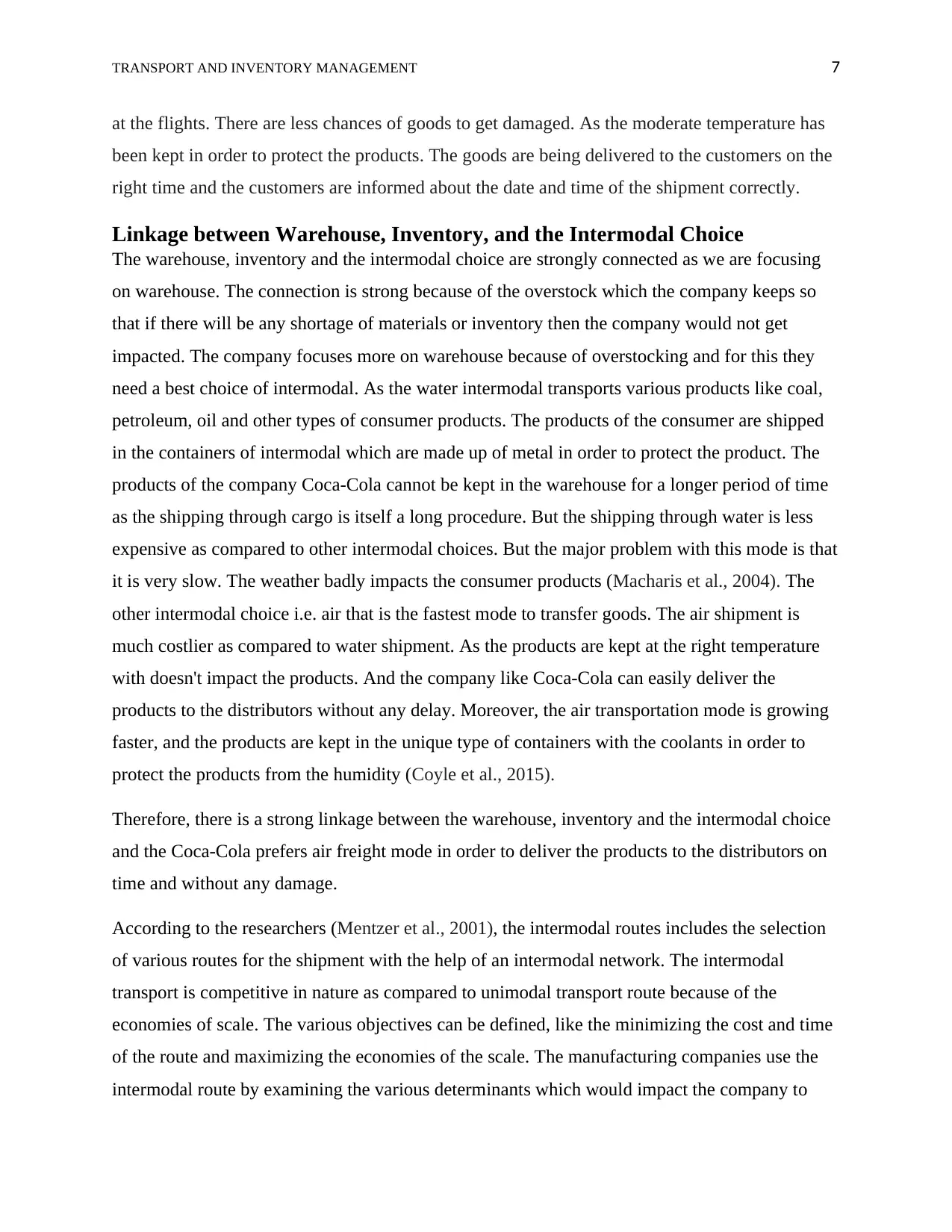
TRANSPORT AND INVENTORY MANAGEMENT 7
at the flights. There are less chances of goods to get damaged. As the moderate temperature has
been kept in order to protect the products. The goods are being delivered to the customers on the
right time and the customers are informed about the date and time of the shipment correctly.
Linkage between Warehouse, Inventory, and the Intermodal Choice
The warehouse, inventory and the intermodal choice are strongly connected as we are focusing
on warehouse. The connection is strong because of the overstock which the company keeps so
that if there will be any shortage of materials or inventory then the company would not get
impacted. The company focuses more on warehouse because of overstocking and for this they
need a best choice of intermodal. As the water intermodal transports various products like coal,
petroleum, oil and other types of consumer products. The products of the consumer are shipped
in the containers of intermodal which are made up of metal in order to protect the product. The
products of the company Coca-Cola cannot be kept in the warehouse for a longer period of time
as the shipping through cargo is itself a long procedure. But the shipping through water is less
expensive as compared to other intermodal choices. But the major problem with this mode is that
it is very slow. The weather badly impacts the consumer products (Macharis et al., 2004). The
other intermodal choice i.e. air that is the fastest mode to transfer goods. The air shipment is
much costlier as compared to water shipment. As the products are kept at the right temperature
with doesn't impact the products. And the company like Coca-Cola can easily deliver the
products to the distributors without any delay. Moreover, the air transportation mode is growing
faster, and the products are kept in the unique type of containers with the coolants in order to
protect the products from the humidity (Coyle et al., 2015).
Therefore, there is a strong linkage between the warehouse, inventory and the intermodal choice
and the Coca-Cola prefers air freight mode in order to deliver the products to the distributors on
time and without any damage.
According to the researchers (Mentzer et al., 2001), the intermodal routes includes the selection
of various routes for the shipment with the help of an intermodal network. The intermodal
transport is competitive in nature as compared to unimodal transport route because of the
economies of scale. The various objectives can be defined, like the minimizing the cost and time
of the route and maximizing the economies of the scale. The manufacturing companies use the
intermodal route by examining the various determinants which would impact the company to
at the flights. There are less chances of goods to get damaged. As the moderate temperature has
been kept in order to protect the products. The goods are being delivered to the customers on the
right time and the customers are informed about the date and time of the shipment correctly.
Linkage between Warehouse, Inventory, and the Intermodal Choice
The warehouse, inventory and the intermodal choice are strongly connected as we are focusing
on warehouse. The connection is strong because of the overstock which the company keeps so
that if there will be any shortage of materials or inventory then the company would not get
impacted. The company focuses more on warehouse because of overstocking and for this they
need a best choice of intermodal. As the water intermodal transports various products like coal,
petroleum, oil and other types of consumer products. The products of the consumer are shipped
in the containers of intermodal which are made up of metal in order to protect the product. The
products of the company Coca-Cola cannot be kept in the warehouse for a longer period of time
as the shipping through cargo is itself a long procedure. But the shipping through water is less
expensive as compared to other intermodal choices. But the major problem with this mode is that
it is very slow. The weather badly impacts the consumer products (Macharis et al., 2004). The
other intermodal choice i.e. air that is the fastest mode to transfer goods. The air shipment is
much costlier as compared to water shipment. As the products are kept at the right temperature
with doesn't impact the products. And the company like Coca-Cola can easily deliver the
products to the distributors without any delay. Moreover, the air transportation mode is growing
faster, and the products are kept in the unique type of containers with the coolants in order to
protect the products from the humidity (Coyle et al., 2015).
Therefore, there is a strong linkage between the warehouse, inventory and the intermodal choice
and the Coca-Cola prefers air freight mode in order to deliver the products to the distributors on
time and without any damage.
According to the researchers (Mentzer et al., 2001), the intermodal routes includes the selection
of various routes for the shipment with the help of an intermodal network. The intermodal
transport is competitive in nature as compared to unimodal transport route because of the
economies of scale. The various objectives can be defined, like the minimizing the cost and time
of the route and maximizing the economies of the scale. The manufacturing companies use the
intermodal route by examining the various determinants which would impact the company to
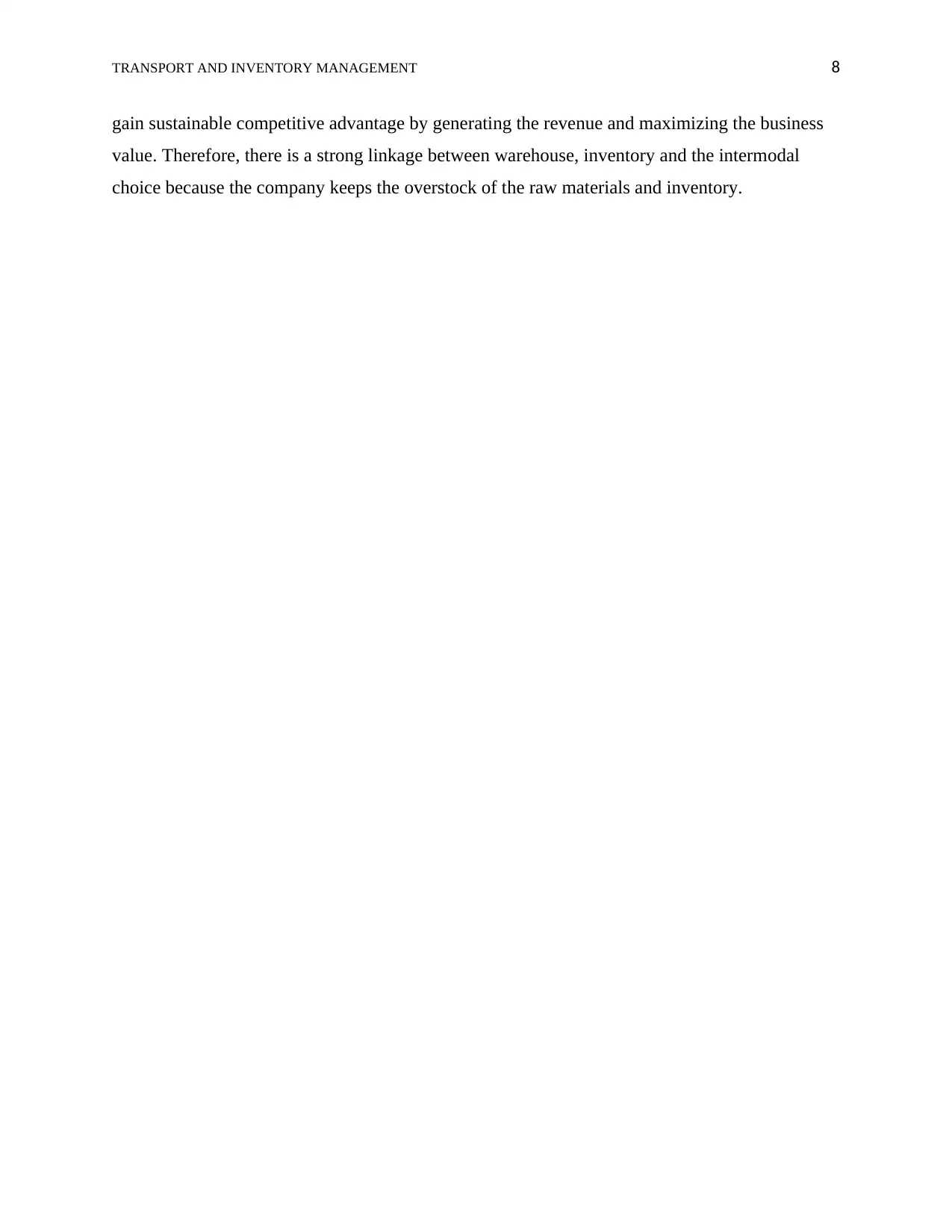
TRANSPORT AND INVENTORY MANAGEMENT 8
gain sustainable competitive advantage by generating the revenue and maximizing the business
value. Therefore, there is a strong linkage between warehouse, inventory and the intermodal
choice because the company keeps the overstock of the raw materials and inventory.
gain sustainable competitive advantage by generating the revenue and maximizing the business
value. Therefore, there is a strong linkage between warehouse, inventory and the intermodal
choice because the company keeps the overstock of the raw materials and inventory.
⊘ This is a preview!⊘
Do you want full access?
Subscribe today to unlock all pages.

Trusted by 1+ million students worldwide
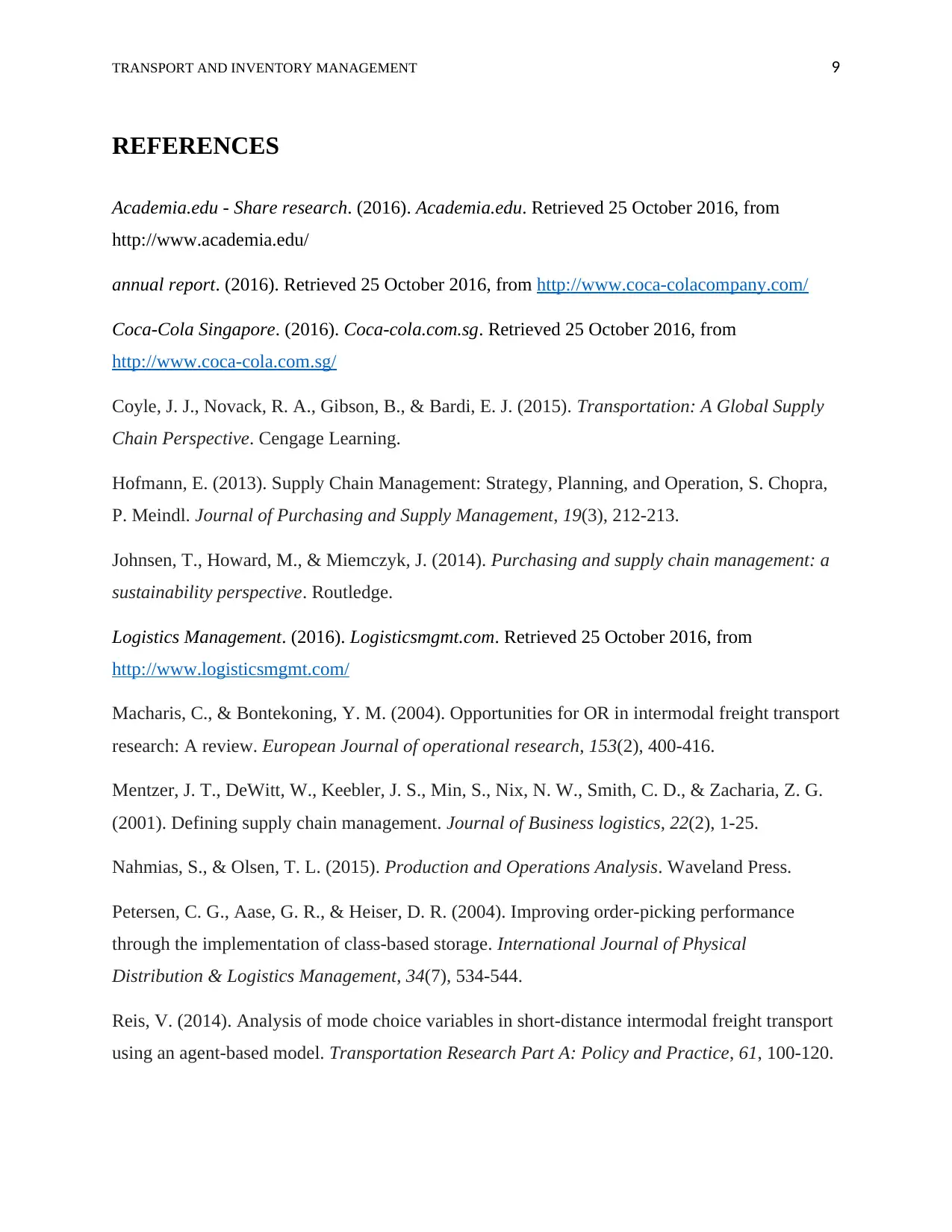
TRANSPORT AND INVENTORY MANAGEMENT 9
REFERENCES
Academia.edu - Share research. (2016). Academia.edu. Retrieved 25 October 2016, from
http://www.academia.edu/
annual report. (2016). Retrieved 25 October 2016, from http://www.coca-colacompany.com/
Coca-Cola Singapore. (2016). Coca-cola.com.sg. Retrieved 25 October 2016, from
http://www.coca-cola.com.sg/
Coyle, J. J., Novack, R. A., Gibson, B., & Bardi, E. J. (2015). Transportation: A Global Supply
Chain Perspective. Cengage Learning.
Hofmann, E. (2013). Supply Chain Management: Strategy, Planning, and Operation, S. Chopra,
P. Meindl. Journal of Purchasing and Supply Management, 19(3), 212-213.
Johnsen, T., Howard, M., & Miemczyk, J. (2014). Purchasing and supply chain management: a
sustainability perspective. Routledge.
Logistics Management. (2016). Logisticsmgmt.com. Retrieved 25 October 2016, from
http://www.logisticsmgmt.com/
Macharis, C., & Bontekoning, Y. M. (2004). Opportunities for OR in intermodal freight transport
research: A review. European Journal of operational research, 153(2), 400-416.
Mentzer, J. T., DeWitt, W., Keebler, J. S., Min, S., Nix, N. W., Smith, C. D., & Zacharia, Z. G.
(2001). Defining supply chain management. Journal of Business logistics, 22(2), 1-25.
Nahmias, S., & Olsen, T. L. (2015). Production and Operations Analysis. Waveland Press.
Petersen, C. G., Aase, G. R., & Heiser, D. R. (2004). Improving order-picking performance
through the implementation of class-based storage. International Journal of Physical
Distribution & Logistics Management, 34(7), 534-544.
Reis, V. (2014). Analysis of mode choice variables in short-distance intermodal freight transport
using an agent-based model. Transportation Research Part A: Policy and Practice, 61, 100-120.
REFERENCES
Academia.edu - Share research. (2016). Academia.edu. Retrieved 25 October 2016, from
http://www.academia.edu/
annual report. (2016). Retrieved 25 October 2016, from http://www.coca-colacompany.com/
Coca-Cola Singapore. (2016). Coca-cola.com.sg. Retrieved 25 October 2016, from
http://www.coca-cola.com.sg/
Coyle, J. J., Novack, R. A., Gibson, B., & Bardi, E. J. (2015). Transportation: A Global Supply
Chain Perspective. Cengage Learning.
Hofmann, E. (2013). Supply Chain Management: Strategy, Planning, and Operation, S. Chopra,
P. Meindl. Journal of Purchasing and Supply Management, 19(3), 212-213.
Johnsen, T., Howard, M., & Miemczyk, J. (2014). Purchasing and supply chain management: a
sustainability perspective. Routledge.
Logistics Management. (2016). Logisticsmgmt.com. Retrieved 25 October 2016, from
http://www.logisticsmgmt.com/
Macharis, C., & Bontekoning, Y. M. (2004). Opportunities for OR in intermodal freight transport
research: A review. European Journal of operational research, 153(2), 400-416.
Mentzer, J. T., DeWitt, W., Keebler, J. S., Min, S., Nix, N. W., Smith, C. D., & Zacharia, Z. G.
(2001). Defining supply chain management. Journal of Business logistics, 22(2), 1-25.
Nahmias, S., & Olsen, T. L. (2015). Production and Operations Analysis. Waveland Press.
Petersen, C. G., Aase, G. R., & Heiser, D. R. (2004). Improving order-picking performance
through the implementation of class-based storage. International Journal of Physical
Distribution & Logistics Management, 34(7), 534-544.
Reis, V. (2014). Analysis of mode choice variables in short-distance intermodal freight transport
using an agent-based model. Transportation Research Part A: Policy and Practice, 61, 100-120.
Paraphrase This Document
Need a fresh take? Get an instant paraphrase of this document with our AI Paraphraser
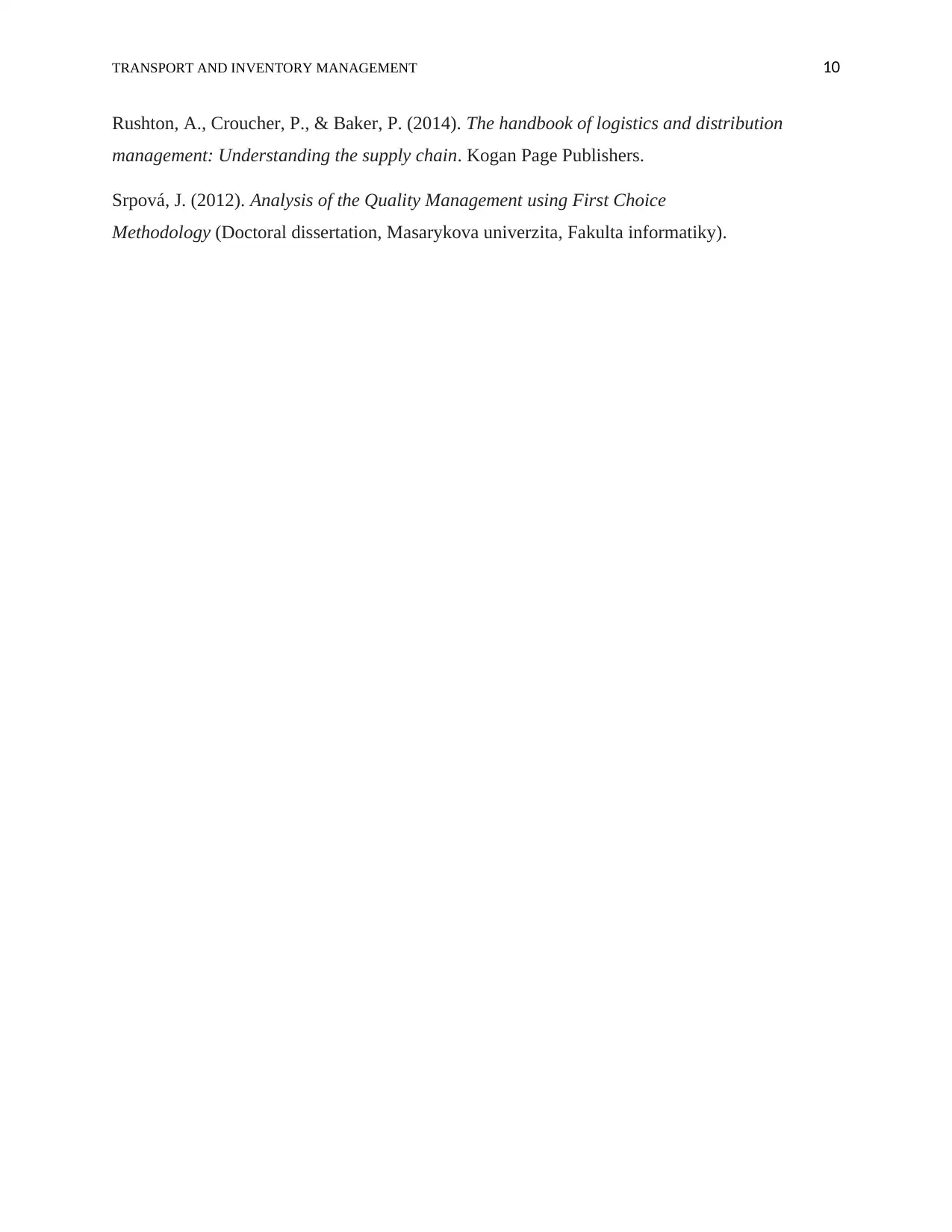
TRANSPORT AND INVENTORY MANAGEMENT 10
Rushton, A., Croucher, P., & Baker, P. (2014). The handbook of logistics and distribution
management: Understanding the supply chain. Kogan Page Publishers.
Srpová, J. (2012). Analysis of the Quality Management using First Choice
Methodology (Doctoral dissertation, Masarykova univerzita, Fakulta informatiky).
Rushton, A., Croucher, P., & Baker, P. (2014). The handbook of logistics and distribution
management: Understanding the supply chain. Kogan Page Publishers.
Srpová, J. (2012). Analysis of the Quality Management using First Choice
Methodology (Doctoral dissertation, Masarykova univerzita, Fakulta informatiky).
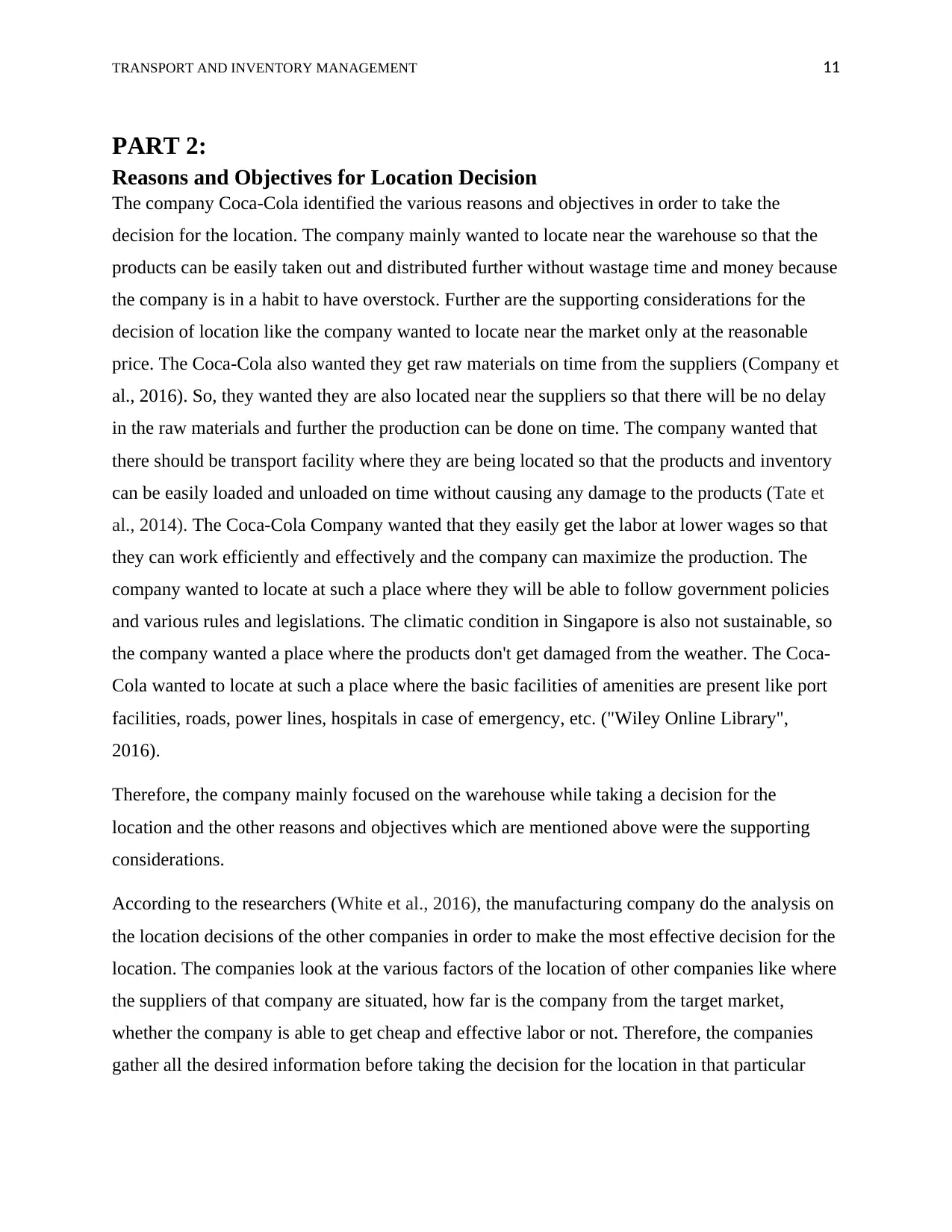
TRANSPORT AND INVENTORY MANAGEMENT 11
PART 2:
Reasons and Objectives for Location Decision
The company Coca-Cola identified the various reasons and objectives in order to take the
decision for the location. The company mainly wanted to locate near the warehouse so that the
products can be easily taken out and distributed further without wastage time and money because
the company is in a habit to have overstock. Further are the supporting considerations for the
decision of location like the company wanted to locate near the market only at the reasonable
price. The Coca-Cola also wanted they get raw materials on time from the suppliers (Company et
al., 2016). So, they wanted they are also located near the suppliers so that there will be no delay
in the raw materials and further the production can be done on time. The company wanted that
there should be transport facility where they are being located so that the products and inventory
can be easily loaded and unloaded on time without causing any damage to the products (Tate et
al., 2014). The Coca-Cola Company wanted that they easily get the labor at lower wages so that
they can work efficiently and effectively and the company can maximize the production. The
company wanted to locate at such a place where they will be able to follow government policies
and various rules and legislations. The climatic condition in Singapore is also not sustainable, so
the company wanted a place where the products don't get damaged from the weather. The Coca-
Cola wanted to locate at such a place where the basic facilities of amenities are present like port
facilities, roads, power lines, hospitals in case of emergency, etc. ("Wiley Online Library",
2016).
Therefore, the company mainly focused on the warehouse while taking a decision for the
location and the other reasons and objectives which are mentioned above were the supporting
considerations.
According to the researchers (White et al., 2016), the manufacturing company do the analysis on
the location decisions of the other companies in order to make the most effective decision for the
location. The companies look at the various factors of the location of other companies like where
the suppliers of that company are situated, how far is the company from the target market,
whether the company is able to get cheap and effective labor or not. Therefore, the companies
gather all the desired information before taking the decision for the location in that particular
PART 2:
Reasons and Objectives for Location Decision
The company Coca-Cola identified the various reasons and objectives in order to take the
decision for the location. The company mainly wanted to locate near the warehouse so that the
products can be easily taken out and distributed further without wastage time and money because
the company is in a habit to have overstock. Further are the supporting considerations for the
decision of location like the company wanted to locate near the market only at the reasonable
price. The Coca-Cola also wanted they get raw materials on time from the suppliers (Company et
al., 2016). So, they wanted they are also located near the suppliers so that there will be no delay
in the raw materials and further the production can be done on time. The company wanted that
there should be transport facility where they are being located so that the products and inventory
can be easily loaded and unloaded on time without causing any damage to the products (Tate et
al., 2014). The Coca-Cola Company wanted that they easily get the labor at lower wages so that
they can work efficiently and effectively and the company can maximize the production. The
company wanted to locate at such a place where they will be able to follow government policies
and various rules and legislations. The climatic condition in Singapore is also not sustainable, so
the company wanted a place where the products don't get damaged from the weather. The Coca-
Cola wanted to locate at such a place where the basic facilities of amenities are present like port
facilities, roads, power lines, hospitals in case of emergency, etc. ("Wiley Online Library",
2016).
Therefore, the company mainly focused on the warehouse while taking a decision for the
location and the other reasons and objectives which are mentioned above were the supporting
considerations.
According to the researchers (White et al., 2016), the manufacturing company do the analysis on
the location decisions of the other companies in order to make the most effective decision for the
location. The companies look at the various factors of the location of other companies like where
the suppliers of that company are situated, how far is the company from the target market,
whether the company is able to get cheap and effective labor or not. Therefore, the companies
gather all the desired information before taking the decision for the location in that particular
⊘ This is a preview!⊘
Do you want full access?
Subscribe today to unlock all pages.

Trusted by 1+ million students worldwide
1 out of 16
Related Documents
Your All-in-One AI-Powered Toolkit for Academic Success.
+13062052269
info@desklib.com
Available 24*7 on WhatsApp / Email
![[object Object]](/_next/static/media/star-bottom.7253800d.svg)
Unlock your academic potential
Copyright © 2020–2025 A2Z Services. All Rights Reserved. Developed and managed by ZUCOL.





